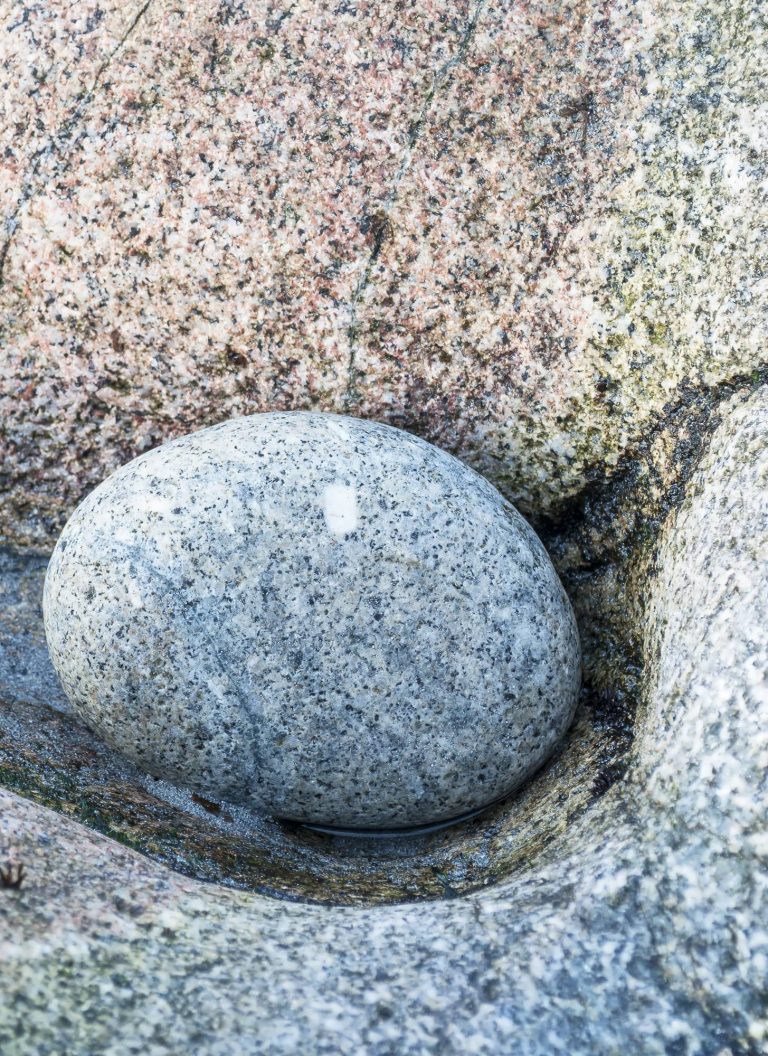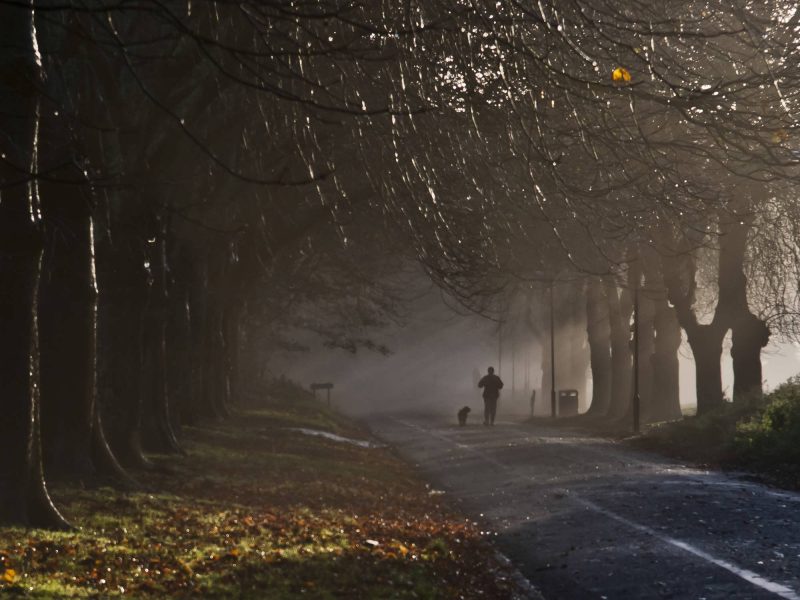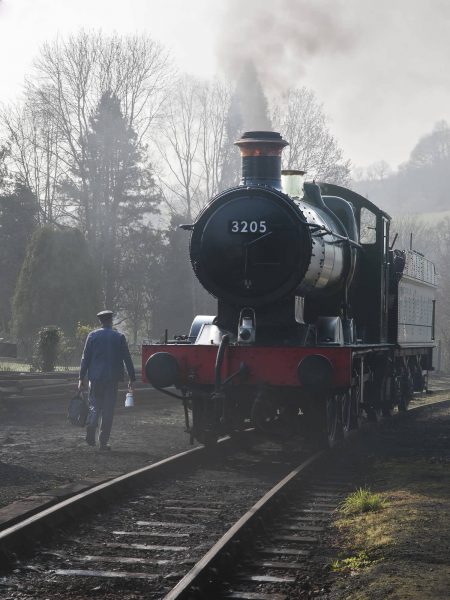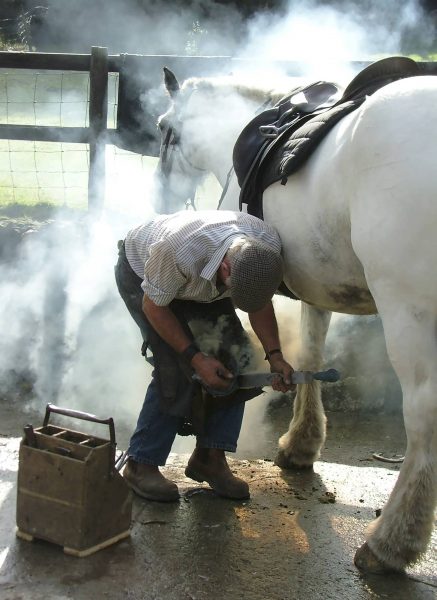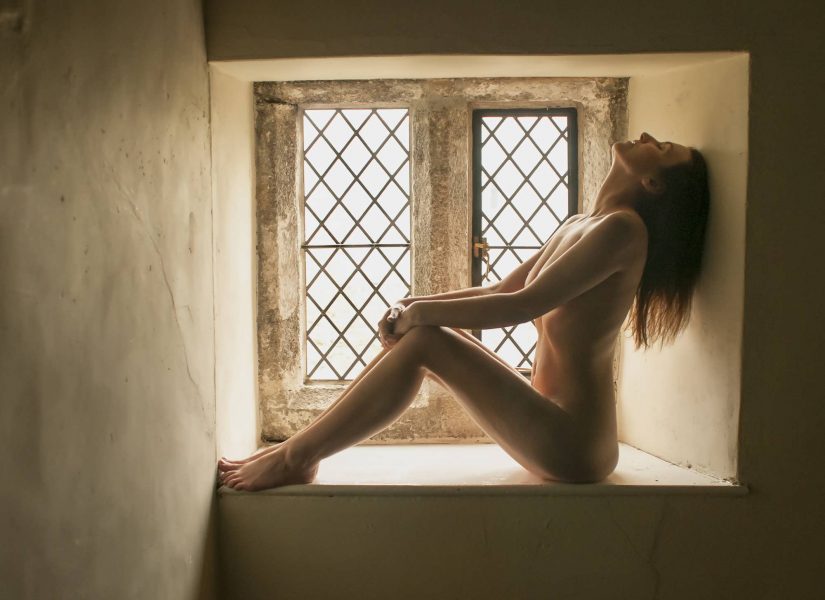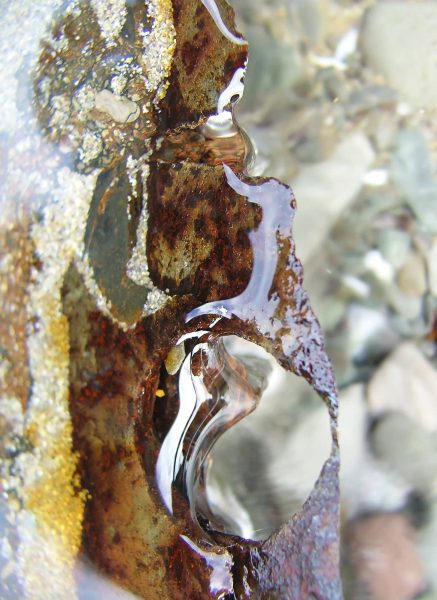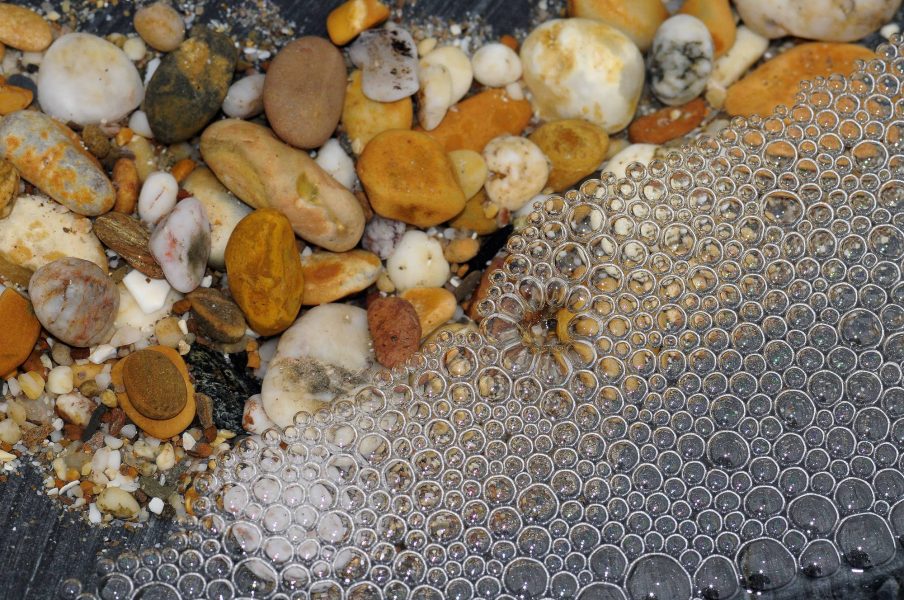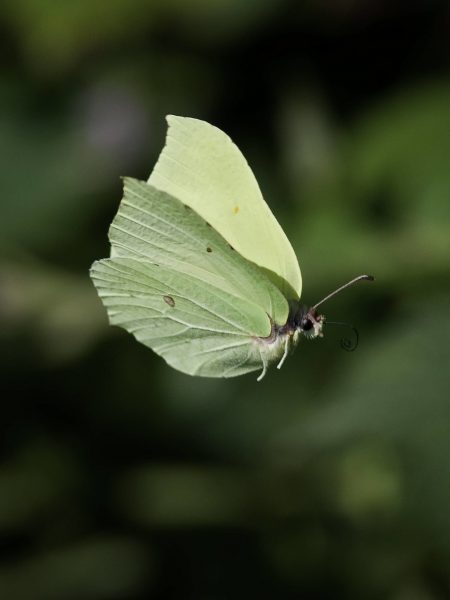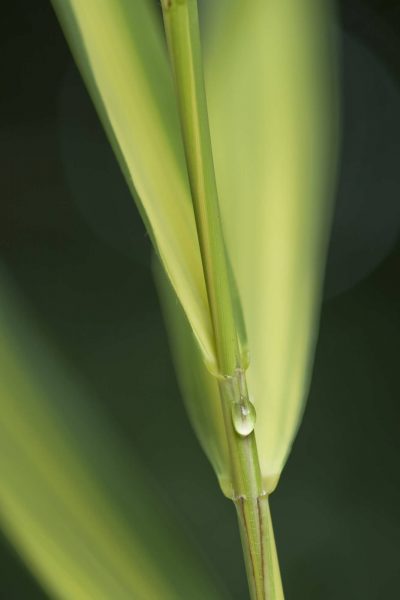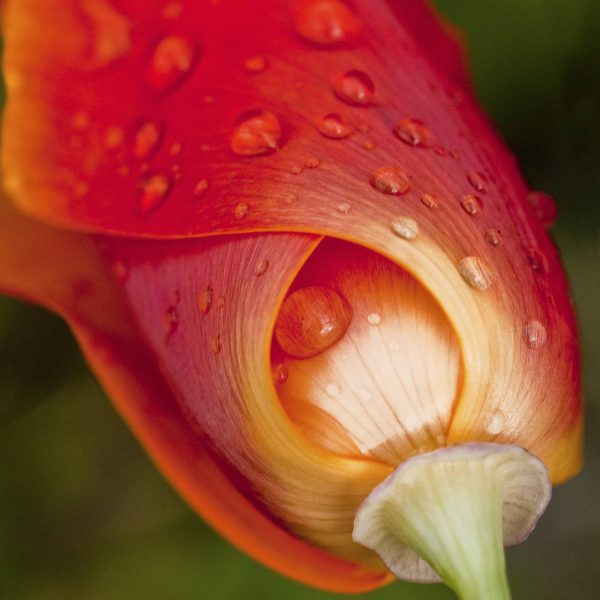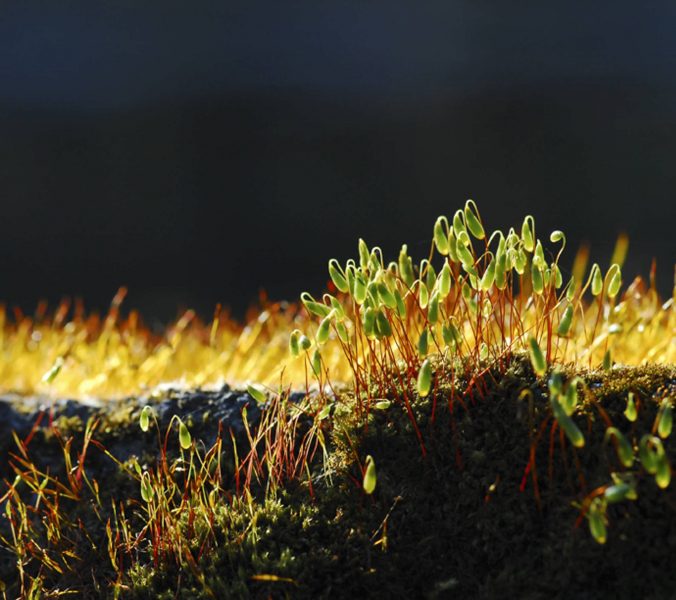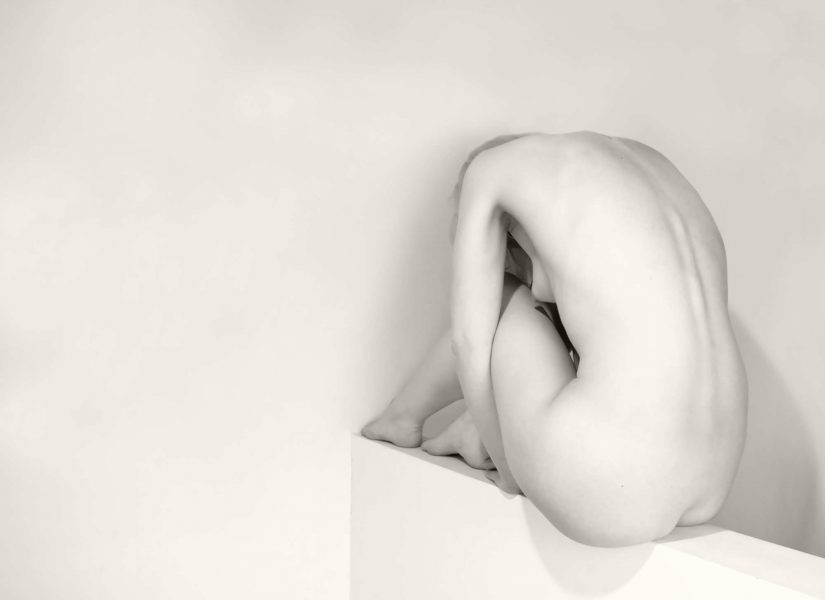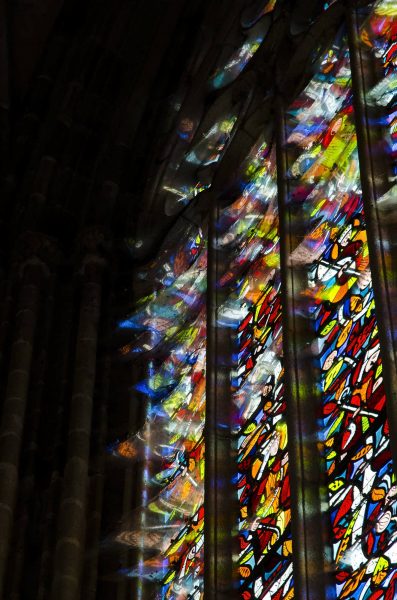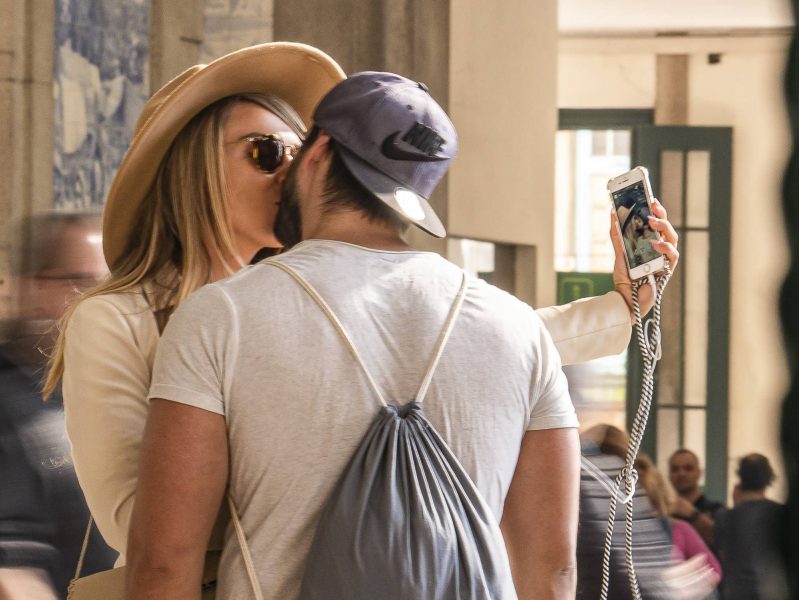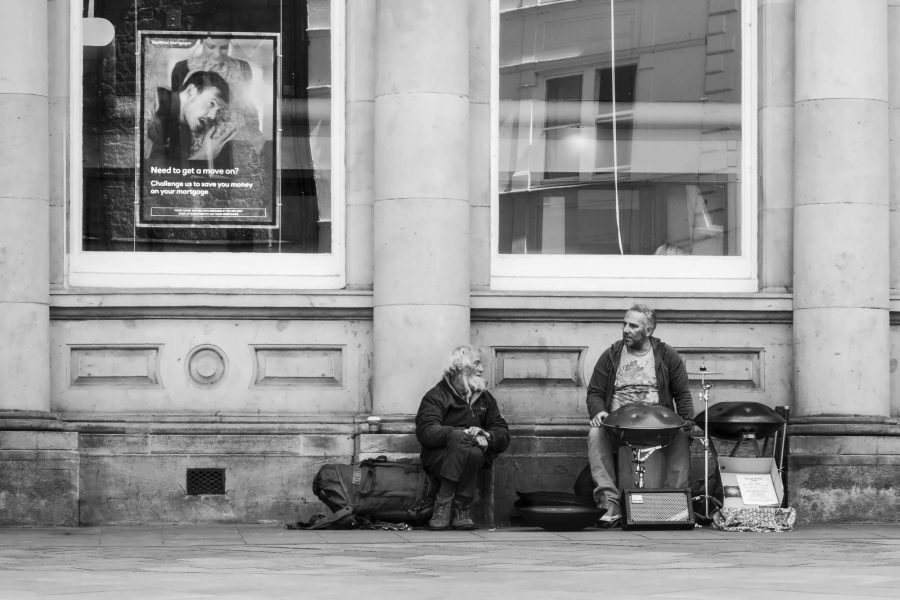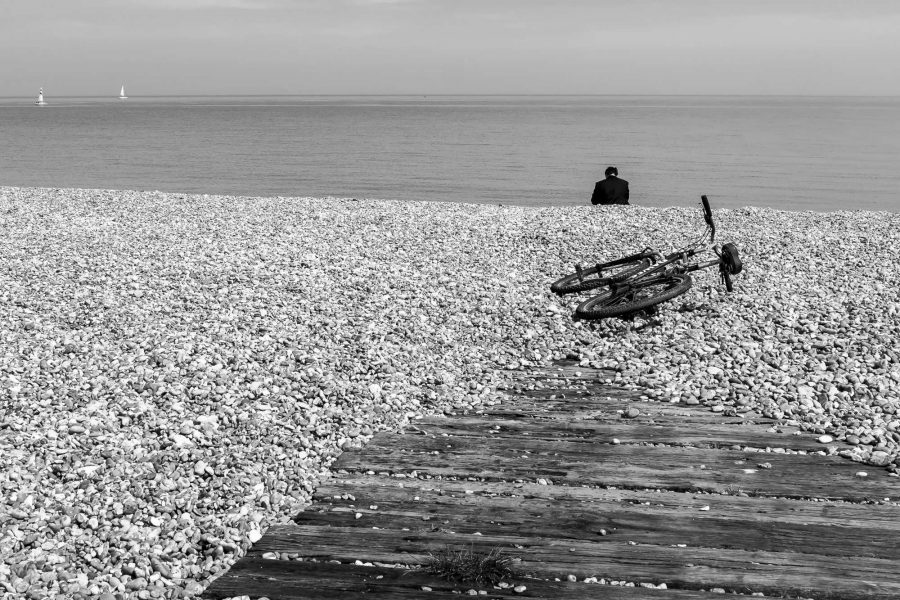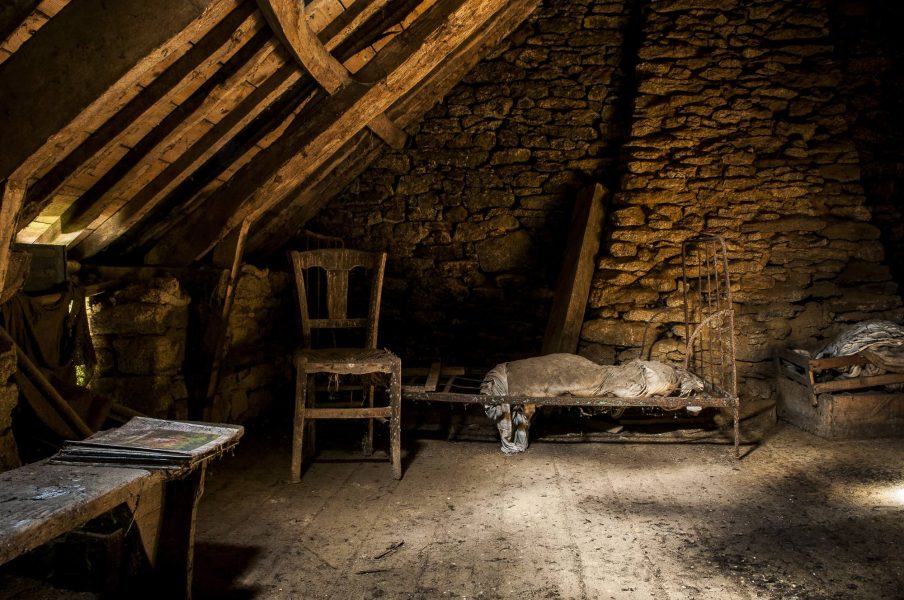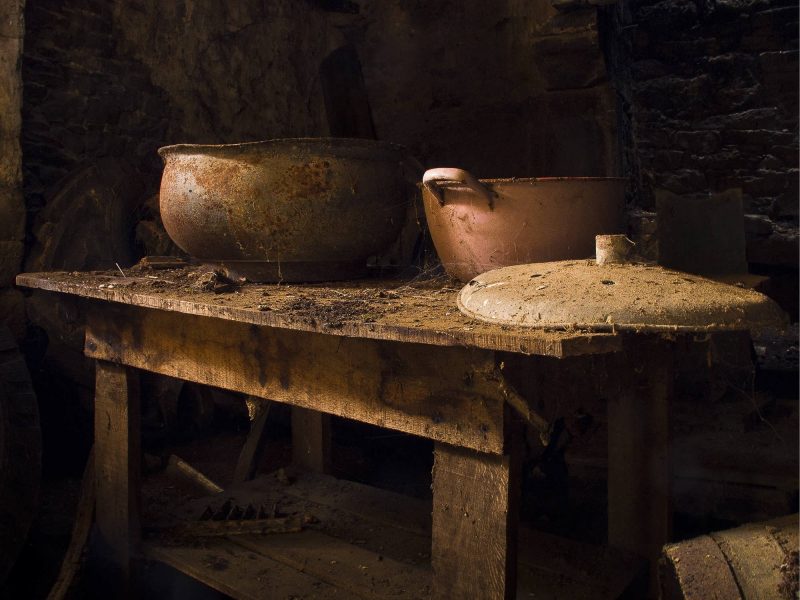Pictures of My Lifetime
Blue rock (2006)
1/60sec f5.6 85mm ISO 250 Nikon D200
I had seen images by Andrew Nadolski, and was immediately smitten with the location he had recorded. It was not until later that I learned the whereabouts of this magical place. It was an area that I did not know well and so, set about discovering it.
Scrambling in an unladylike manner, as is my wont, to the area to the south of the main Porth Nanven beach, I discovered Nanven with its astounding wave cut, granite platform. The actions of the rounded rocks on this structure had carved out perfect hollows, and in many of these, resided boulders, rocks and pebbles of beautiful, unusual colours. This blue rock had found its niche until another tide dictated that it found a new home.
The composition is not conventional, but I find it satisfying.
Another reason why this image finds its way into this category is that it was the first picture that I framed for my first solo exhibition. I had a devastating car accident in which I was very fortunate not to lose the sight of my right eye. I had to focus on healing so that I would be fit to frame, hang my work, and steward my exhibition at Stuart House in Liskeard. It took great will power not to touch the newly acquired frames, until I was sufficiently healed.
When I had put the mounted print into its frame, I stepped back and cried, because seeing the end result I knew why my sight had been spared, and that I had to repay all those who had helped me, by continuing to take images that would interest and encourage others to look and see for themselves.
Ashtor Rock and Royal Albert Bridge (2009)
1/320sec. f9 17mm ISO 200 Nikon D300
From home, it is possible to see the river mists rising in the valley of the River Tamar. One October morning, I watched the mists forming as I prepared to travel to a portrait commission in the far west of Cornwall. Crossing the Tamar Bridge ten minutes later, I was drawn from my route as I felt that the colour of the mists was unlike anything I had seen before. I diverted through Saltash to take the road to the river’s edge.
The light reflecting in the windows of Ashtor Rock set the scene alight and the natural elements provided paths taking the viewer’s eye on secure routes throughout the composition of the picture, but drawing the eye back to the windows every time.
Within minutes, this ephemeral atmosphere was dissipated as harsh shafts of sunlight broke through the scene.
I had not seen colour in that area like that before, and it was a challenge to process the image accurately for printing, so that the finished product replicated the colour and atmosphere and mood of those few minutes
Central Park, October morning (2010)
1/160sec f7.1 55mm ISO 400 Nikon D300
The family home of 60 years had to be sold. As I drove there for the very final reading of the meters, I passed Central Park in Plymouth as the early morning mists enveloped everything. I was willing the meter reader to be on time because I was frantically impatient to catch the mists before they disappeared.
Time keeping was perfect, but I was desperate to close the door, lock up and escape to this exact spot. The trees of my childhood walks filtered the bright rising light into distinct shafts. Autumn-prepared branches stole the diamond-illuminated dew coating as their own, whilst a lone leaf clung tenaciously.
I am always drawn on along the path, scuffing up the damp leaves, courteously greeting the dog walker, allowing the smell of autumn to permeate my memory.
First Train of the Day (2012)
1/250sec. f9 55mm ISO 250 Nikon D300
For a few years, I was Assistant Resident Photographer at the South Devon Railway. This gave me the good fortune and privilege to have access to the sheds, and lineside, paying careful regard to all of the essential safety procedures.
In order to prepare a loco for operation, the work has to start a very long time in advance, requiring a very early start by the crew. It is only after several hours that the loco can leave the sheds to start the day’s running. This capture of walking to the cab with the vital billy can and robust leather railway bag summed up so many aspects of the Railway on this early spring morning.
Learning to read the steam and smoke, listening to the sounds to tell me what was happening, or going to happen, was a great learning experience, and the opportunity to work with amazing , knowledgeable characters was indeed a privilege.
The Farrier (2005)
1/500sec f5 10.7mm ISO160 Fuji FinePix S5000
For my son’s 17th birthday, he wanted to go horse riding, and I happily took the guys to the stables. I was left in the yard as they went off, but I was not alone; I had my trusty Fuji 3 Mpx, jpeg only, camera with me.
As the farrier worked, my attention was captured. This image was one of just two that I took as he worked. Composition could certainly have been better, but the image was taken in the early days of me realising that I had to have a camera with me wherever I went, and it was indeed opportunistic.
This picture is possibly the first landmark in my early work, because it proved several things to me. I could subconsciously observe every moment that made me instinctively know when I would capture what I wanted the scene to say. That I had just one chance to get the lighting right. That I could anticipate movement (look at his left foot) to capture the story as it unfolds. The split second later, the entire scene was engulfed in the smoke.and the moment had passed. That I knew the capability of my camera to achieve an image that required no processing from either Photoshop or Lightroom to achieve the result I wanted.
‘The farrier’ gave me the confidence to carry a camera with me at all times, and to use it in the knowledge that I had the potential to make it work for me to capture my observations.
Holly in the Window (2008)
1/60sec. f4 35mm ISO 500
Photographing the nude form is one of my passions. All bodies have their beauty because honest personality can shine through the unclothed form in a way that is totally hidden by clothing.
This is an image that I took on Holly’s first ever nude shoot. The ability to inspire confidence with someone with whom you are working is paramount, as is total trust and respect. The knowledge that I know what it is like to be on both sides of the camera is also a very positive, beneficial factor.
Holly’s pose reflects qualities for which I search. Her pose is not unnatural; there is no element of preconceived stereotypical ideas that others might hold. She is herself. She is comfortable. It reflects my instruction to her that she should explore the space of the window sill. Soft, natural light is my favoured light. The less clutter there is around a shoot, the more relaxed it is, and the knowledge of the camera’s capabilities, and my capabilities as a photographer and woman, mean that I can focus wholeheartedly on the person with whom I am working.
The first print of this image is most definitely the property of the photographer and it holds a place on my wall that means that it is seen every day, and I never tire of it.
Beach River Through Rusting Rivet Hole (2005)
1/60s f2.8 5.7mm ISO 200 Fuji FinePix S5000
Beesands Bubbles (2006)
1/400 sec. f10 28mm ISO 250 Nikon D200
The tide was ebbing as I walked along Beesands beach near the rocks at the northern end. Geologically, it is an important area, but one of the fascinations for me has always been in the water worn, smooth sculpted rock forms in the area. I invariably get wet whenever I am by the sea, usually inadvertently, but never dangerously; always watching the pattern of waves, intensity and effects of the wind on the sea. My camera was by my side as a rogue wave raced further in and swamped a smooth, hollowed rock pool. Its impact caused a myriad of bubbles on the surface of the residual water, each of which acted as a perfect lens enhancing all of the tiny pebbles at the base of the depression. The phenomenon lasted but a second and then every bubble had gone. A camera by your side is of no use in that situation.
I had to wait to see if the same thing happened again. The wind dropped. The sea state calmed, subsequent waves avoided their former territory with determination, as the tide continued to ebb. It was not a problem for me to wait. I had nothing to lose, and possibly a lot to gain. There was no comparable rock pool in the vicinity and so I positioned myself astride this raised rock pool, again in a very (un)dignified manner and drew on my reserves of patience. I did not move. My camera was positioned exactly as I knew it would have to be, with the setting exactly as I wanted. I waited, and I waited. Watching the movement of the clouds gave me my first hope as their direction shifted. The sea state picked up slightly. One rogue wave, just one, overcame its temerity, swamped my feet and splashed with a teenage discontented flop into the pool. The split second after that, this image was taken. It had been my only chance, and I was inordinately proud of its capture. No other wave came anywhere close to me after that!
This image to me is an example of observation, reading all the signs around and interpreting them to pick the precise moment for the release of the shutter. It is a reminder of the golden gifts of patience and hope.
‘Outdoor Photography Magazine ‘ selected this picture as a competition winner.
BRIMSTONE BUTTERFLY IN FLIGHT (2011)
1/3200sec f4 105mm ISO320 Nikon D300
In pursuing butterflies in a beautiful wood in Finisterre, I was exceedingly irritated that none of the insects would settle, even for a few seconds so that I could photograph them with my adored 105mm lens. I decided that if I couldn’t catch the butterflies as they settled, I would have to catch them in flight. My first effort had two brimstones together in the air, but the shutter speed was too slow, and the result looked amazingly like an angel with outstretched wings in flight.
I learned from that and continued. I had set the camera on manual focus, so that with my left eye, I could actually track the butterflies,while my right eye was in effect, glued to the view finder. ( Of course, in this way, I can only track from left to right!) This was a single image. I do not use a rapid burst, or any form of motor drive for anything. I rely on my timing to select the precise moment. I believe that for me, a motor drive would make me lazy. I would be relying on mechanics rather than my own observations and instinct. It is a facility that can be very justifiably used by other photographers, but not for me and my style of working.
This image is by no means perfect, but for me, it was a landmark achievement from which I was determined to learn and progress.
Dartmouth Panorama (2010)
1/40sec. f3.5 105mm ISO 250 Nikon D300
I was commissioned to produce a panorama as a record if this incredible piece of art work. Ian Barlow was commissioned to create a mural covering all of the walls of a dining room of a property in Dartmouth, depicting a historical scene of the location. The art work was truly amazing, filled with historical accuracy and imaginative touches that provided amusement and even more interest.
I was unable to photograph the room in its unfurnished state, and this posed a huge number of problems for me. The rectangular room had a chimney breast, and of course the painting covered the returns of the alcoves. The lighting throughout the room was totally uneven and would have required an extensive commercial set up light it evenly. The presence of a huge, totally immovable rectangular table filling the centre of the room meant that I was not able to take the images from a fixed distance from any of the walls. Access to the alcoves also meant a proximity to the subject that was greater than anywhere else.
No photographic programme was available to me to create this panorama. I therefore had to create my own method to achieve this.
Each frame was taken more than once to combat lighting conditions. Natural shadow had to be taken into account as well as the artistic portrayal of shadow in the scenes. Sections were also shot from different heights in areas to make sure that the optimum optical area of the 17-55mm Nikon lens could be utilised. I produced the panorama by cloning, using Photoshop, but also had to resize individual images in order to create consistencey for assembly.
To my annoyance, I had to foreshorten the sides of the chimney breast, rather than using flat projection, to compensate for the prominence of the features of the fireplace.
Without the opportunity to return to the location, I found that my accurate memory of colour qualities was too hazy, because I had been so focused on the technicalities. I was so grateful to be able to return to the artist to rectify this through his guidance.
I remade this panorama five times before I was satisfied that I had produced an acceptable result.
My gratitude to Ian Barlow for permission to reproduce his art work for the web site.
Place Miroir d'eau, Bordeaux
1/40sec. f3.5 105mm ISO 250 Nikon D300
Droplet on grass (2009)
1/40sec. f3.5 105mm ISO250 Nikon D300
The Garden House at Buckland Monachorum is located within easy distance from home, and in the past, I was granted access to these beautiful gardens outside the normal opening hours. All of the work that I produced was available for use by this small charity for several years, and I was able to hold exhibitions of the work I took there as ‘Garden in the House’.
This late afternoon image stood out for me, and think for many visitors, and other viewers, because of its simplicity and sense of calm. I find it an image that I can look at every day and it never ceases to imbue within me that sense of peace at the end of the day as the sun’s rays lose their strength and a gentleness settles at the shuffling down after a busy day.
Escholzia california (2009)
1/60sec f8 105mm ISO250 Nikon D300
Ever since the days of using extension rings on the old Fuji S5000, I have loved the world of macro photography. The patterns and forms take on different sculptural and textural elements and provide clues about the make up of the subjects that may otherwise escape our awareness.
To my great amusement, my floral macro work has been likened to the work of Georgia O’Keeffe. I would disagree with that. I am not interpreting what is there through manual means of paint; I am drawing with the aid of light what is actually visible, with possible cropping my only need for interpretation.
This Californian poppy’s home was The Garden House at Buckland Monachorum. It was photographed after evening rain fall, before gravity and the last of the summer evening’s heat made the droplets disappear. I have often been asked whether I spray plants to utilise the forms of water droplets. I do not, although some people choose to do so. Observation has shown me that it is very easy for me to differentiate between natural and staged. I find the irregularity of natural moisture far more interesting than the regularity of patterns created by a hand spray.
I submitted this image for a Royal Horticultural Society competition and was fortunate enough to to receive an honourable mention.
Pohlia nutans (2007)
1/320sec. f9 105mm ISO 400 Nikon D200
People working with me on a nude shoot know well that my attention can easily momentarily wander, as something else takes my interest in my peripheral vision. A fun shoot with a lovely model in Wistman’s Wood on Dartmoor, saw exactly those circumstances.
I turned and from my low position, saw these exquisite mosses colourfully backlit on a granite boulder. The shot was instantly taken and I rapidly returned my attention to my model, thinking little more of the additional files that dotted the memory card in my camera.
As I started to process the images at the end of the day, this picture shone out, but I filed its presence in my mind’s eye and concentrated on the main purpose of the shoot.
Preparing to enter a Royal Horticultural Society photographic competition in the plant portrait category, this image came to mind, was submitted and won Second Place in that category in 2008.
Linda curled (2010)
1/50sec f3.5 17mm ISO400 Nikon D300
Linda is an experienced model who has worked with many photographers. She is naturally very creative and readily slots into the styles required of her. We are both amused at the start of any shoot together because I always have to remind her; “You are working with me.” There is almost an audible sigh as the comfy slippers of relaxation engulf the soul, and preconceived ideas are shed like outdoor stiletto heels, as she becomes totally her natural self, but still retaining the spark of creative awareness of form and fun.
Many years ago, she was living in a flat where there was a partial room divider wall. Of the various poses with which she experimented, this simple curl has provided an enduring image. There is a studied gentleness about the form, but huge awareness of sculptural impact.
Composition-wise, it could be said to break so many rules. So what? Nobody taught me the rules, so I am at liberty to break them. .
Kemi standing (2012)
1/20sec f7.1 23mm ISO 200 Nikon D300
It is always a great pleasure and privilege to work with Kemi. Each time we work together, I have great difficulty in catching her without a huge grin on her face. I love working with the nude form in the landscape. My instructions are always; “Go and explore that area”. The delight of exploring new forms, new shapes, new textures and seeing how the body reacts in those spaces produces spontaneous, natural work, and the wonderment, curiosity and ease of the model is always evident in the end results.
Having been a photographic model myself, I am so aware of what it is like to be on the other side of the camera, and the vulnerabilities that could be felt by a model. I therefore make certain that the surroundings are safe in every sense, and constant vigilance ensures that no harm, physical or mental, befalls them. I would never ask a model to do anything that I had not done, or would not be prepared to do, and this also lends confidence to the situation. With an adventurous model like Kemi, there is great joy in observing how she uses her strength and imagination to create interest and novelty.
In this image, Kemi was exploring the textures of the silken-smooth granite at Nanven. It is a location where there are what I regard as immensely feminine, but also immensely strong rock formations. The colours of the bed rock vary enormously. It was a luxury to work with a skin that can indicate blue/black tones, it complemented areas of the rock to perfection.
One of the features that I seem to instinctively see in my work , is the echo of body lines in the surroundings. This image indicates how natural lines within the body form continue as projections in the joints, faults and intrusions in the granite., so Kemi was totally ‘at one’ with her environment.
Plymouth Panorama (2012)
Camera Info
Sheer lunacy! Who stands at Penlee Battery, overlooking Plymouth Sound, with a Nikon D300, a Nikon 70-200mm lens, no tripod, and decides to take pictures for a panorama extending from Maker Church to Bovisand? You’ve guessed it. 32 images, hand held, hand supported, in a very stiff breeze.
As I was taking it , I did wonder, “Why?” The answer is, ” Because it is there to do!” So I did.
To create something that size puts a bit of a strain on the capacity of a laptop, or some desk top computers. I created it by my own means of cloning in Photoshop, with portrait format images. The incredibly silly thing was that having created the image, I produced a print from it. 20cm in height and 2.5m (8ft ) long. The totally idiotic thing was to mount it on a piece of MDF for my exhibition at Harbour House in Kingsbridge that I was setting up the following day. I was totally amazed. I succeeded! Sadly with 25cm to go, the self adhesive backing ceased to detach smoothly as it went through the press, and I landed up with a tiny wrinkle running vertically through the print. Hey ho! What a learning curve! One final point about that mounted print: my shed is just 6m long.
IF required, that panorama could be printed to 1.2m high, without a loss of quality, but of course, that would mean that the length would be 12m . There is certainly no problem in identifying individual cars on Plymouth Hoe at that size.
Treguire Cathedral (2013)
1/40sec f5.6 85mm ISO 200
In my exhibition at Harbour House in 2014, a print of this image took pride of place in a prominent position. It stopped many people in their tracks as they attempted to work our what they were seeing. The mischievous side of my nature came to the fore as I took extreme pleasure in one little group of very mature people as they pondered. One, who decided that he would have to demonstrate his superior knowledge of everything to the mere mortals at his side, explained that I had achieved the effects they saw by looking up at a window and moving ‘Very, very, very slightly to achieve the blurring. ‘, I could resist no longer. I asked him why parts of this single image remained pinpoint sharp if there had been any movement at all, if it was shot at 1/40 second. No answer was forthcoming. None of the little group could work out what was in the image, other than a stained glass window. I explained what they were seeing, to the great amusement of the gentleman’s two lady companions.
This is an illustration of how easy it is to look at things from just eye level and not up, or down. I was looking up at these magnificent windows as the sun streamed in, creating brilliant patterns on the floor. Indeed, it was the patterns on the ground that lured me in to the Cathedral. On looking up, I noted the fascinating effects as coloured light seemed to hang freely in space. This phenomenon was caused by the inaccessibility of the windows to cleaners. Over time, spiders have claimed the area for their own, creating webs extending to the mullions and transoms. Each fibre of their webs caught and trapped the reflection of the coloured light, replicating the detail of the section of the window from which each pattern emanated.
It is by observing details like this that I have been able to learn so much. This image tells so many stories. The obvious history of the cathedral, the architectural detail, the care and maintenance in the present day, but also the time of day, just through matching the detail on the webs with the angle of the source of light.
Carefully staged (2020)
1/8sec f10 100mm ISO 200 Panasonic GX7
Sometimes, it is necessary to grab a scene as it unfolds. The speed at which that ‘grab’ may need to be taken, may not afford the luxury of setting the camera perfectly to achieve perfect technical qualities.
I had been recording the tiles in the spectacular railway station in Porto and was enjoying chocolate and a very late lunch in the adjacent cafe . My camera was still set from that and resting on the table. As always, I was people watching. I had neither the time, nor camouflage to raise the camera to my eye, but had to rely on the back screen and auto focus to obtain this.
This is proof that unless you can see it, the image does not exist, other than in your mind’s eye.
For me, it is an image that creates a story by questions. Arrival? Departure? Personal record? To share on social media? To annoy? To re- affirm? Now it is up to your imagination to create your story, not mine!
Durham message (2015)
1/40sec f8 30.5mm ISO100 Canon PowerShot G11
This image was shot ‘from the hip’ as I walked past without breaking step. I find the rotating, swivel facility mechanism of the back screen of the little Canon camera an immense boon when recording candid street images.
As I approached this scene, not only was my attention held by the busker’s musical instrument, knowing the magical sounds that can be produced from them, but it was the sensitivity of the grime -encrusted hands of the gentleman of the road, as he sat on the complete collection of his worldly possessions. The position of this pair, on a busy summer-tourist filled street was so poignant, under the poster that occupied such a prominence in the Bank’s window.
It is the juxtaposition of features that I appreciate and enjoy recording to hopefully prove thought provoking to others.
Solitude, Deal (2016)
1/320 sec. f11 2mm ISO125 Panasonic GX7
There are some images that I know I will process and print as a monochrome image, and this is one of them. I always shoot in the raw format ( unless it is my little happy snapping phone, when I will convert a any worthwhile image to a non-corruptable format at the first opportunity) .
The sparkling blue of the sea, the cerulean of the lightly, cloud streaked sky, and the gold of the shingle were forsaken to lend strength and power to the image.
It was a lunchtime, and a gentleman in a dark suit pedalled along the sea front in Deal, turned off along the boardwalk, threw his bicycle on the shingle and continued walking to the edge of the shingle ridge where he sat. He is anonymous to you and me, and he always will be. He carried the worries of the world upon his shoulders as was evident from his demeanour and his constant muttering to himself as he passed me.
I positioned myself deliberately in this spot, so that for me, the composition presented a huge strength. I waited until the yachts also where in exactly the location I wanted before taking this single image.
Sometimes, images are far from comfortable, and if the full story behind them is known, our own perceptions can be changed. For me, the phrase of unknown origin, ‘There but for the grace of God go I’ is pertinent, and it is an image that really encourages me to count my many, many blessings.
Plymouth Hoe (2011)
1/500sec f4.5 30.5mm ISO 100 Canon PowerShot G11
I missed the perfect image here!
We had just driven up to The Hoe for a much needed breath of fresh sea air to restore equilibrium at a time of family sadness. Parking close to the main concourse of The Hoe, I instantly grabbed my little camera and was only part way out of the car, having instinctively switched to shutter piority mode as I stood.
To anyone familiar with Plymouth, this scene could have been taken in no other location. The distinctive camber of the Hoe Promenade, the appearance of the lamp post, the lower parts of other promenaders tell us ‘Janners’ the exact location.
The family group, preparing for their activities in the open space, and the perfect silhouette of the little boy, the low, evening sun’s rim lighting of the people made me extemely happy with this instinctive picture.
I gave a talk to a local camera club and during the interval, an elderly gentleman asked me whether there had been a Basset Hound with the group. I answered in the affirmative and he then replied with a variant of an Anglo-Saxon phrase. It was his family that had been immortalized in that split second…….. It was a pity he didn’t buy the print I had on display!
Why was it not the perfect image? From the seeing, to the taking, the Basset Hound had continued on his way, preceding the little boy out of the frame. Some you win, some you still win..
Quinoalc'h (2013)
2sec f11 18mm ISO 200 Nikon D300
Whenever I am driving and I see a really dilapidated building, or ruin, the brakes of the car are almost slammed on, I cruise to find a safe place to stop, and set off to explore. It is living history facing into oblivion and I have a great desire to record it. The stories of people are told there; stories that will be lost as decay wins, or renovation destroys.
In the hamlet of Quinoalc’h in rural Finisterre, quite a substantial cottage is set back from the road, behind a well tended green. I ventured in. The beaten earth floor was evidently the only floor that had ever been there. The garden escapee vinca was attempting to make a home in the hard packed earth. Nothing remained downstairs to give any indication of who had lived in this property. The stairs led steeply to the traditional first floor. Some were missing. Some had rot that sank as my weight was gingerly placed on them. As my head rose above the floor level, my heart missed a beat. Partially against the chimney breast was a single iron bedstead, but on it was a bundle. It was formed as a dead body might be formed. The grime indicated just how long it had been there, untouched. Courage and common sense crawled back into my thinking.
My purpose was to record the scene. Before doing anything to in any way disrupt the scene, I stood carefully at the top of the stairs, braced myself, and took a series of images. Despite the roof’s collapse having created a room with a view, that source of light was to my right. The only other light was from gaps under the eaves. The ‘window’ had been over-hung with sacking. The lack of light was disconcerting. Because I wanted to be able to access as much detail as possible I selected the aperture of f11 that I knew to be where the Nikon 17-55mm would function at its optimum. An ISO of 200 would allow me to make the necessary adjustments with the low light levels when processing, without losing quality. The shutter speed of 2 seconds, hand held just required a lot of physical discipline. It was a scene that I was prepared, and able, to spend time shooting, to get the optimum quality possible.
Knowing that one of the shots would fulfill my wishes, I carefully, oh, so carefully approached over rotting boards. The bundle was purely that: a bundle. Long disused bedding, rolled up and abandoned. A crate of empty bottles of equal antiquity was at the head of the bed. The model for Van Gogh’s chair was by the foot of the bed, its back a perch for itinerant birds, its cane work gently rotting, forgetting the people whose weight it had once borne. On a bench rested a calendar for 1974 . Behind the bench was a large, ancient two man saw. My footsteps on the boards were interesting. I could almost feel them sink with the rot. The hole in the collapsed section of the roof allowed rain water and snow of harsh winters, free access, and had removed all protection from the rotten floor.
I left exhilarated at my find, but saddened by the story.
The opportunity to return came the following year. More of the steep steps would not permit themselves to bear my weight and so I clambered from one safe step to the next. The scene upstairs was unchanged, apart from a more extensive hole and more totally rotten floorboards and holes. The quality of light was poor. There was no point in taking further photographs; they would say nothing new, and they would not speak as eloquently as this one. I respectfully left.
The following year, the staircase was boarded over; this could be seen from the road. The next year, the entire cottage was boarded up.
No-one else can now see what I was able to see, or record it to share with others.
The Outhouse, Kervell (2011)
1 sec. f6.3 6.1mm ISO 200 Canon PowerShot G11
If, in a fire, I could only rescue one print, it would be this one.
In the very quiet hamlet of Kervell in Cotes-D’Armor, Brittany, very old ruins of a variety of buildings took my attention. A gentleman of about 50 was wandering up the road, and I respectfully asked him whether I might photograph the location. I received no reply and watched him continue to lumber up the hill. A few minutes later, a very elderly gentleman appeared. It had been his son that I had seen. I explained my desire to photograph the ruins and he happily gave his permission, and told me the history of the location. These buildings had belonged to his uncle; the farm had been in the family since the 18th century. At one time, the hamlet had been the home to eighty families, now it was home to just eight. The youngest of these was his mentally handicapped son. All of the other youngsters and families had died out, or left the hamlet, seeking the comforts of town living and shunning hard agricultural labour. The gentleman indicated the massive bales of hay in the barn. “You see those bales? They are the last this farm will ever produce.” There was understandable sadness in his voice.
Of the cottage that stood near the road, he told me that it had belonged to his uncle. When he died, his body was carried out of the cottage, the door locked and nobody had been in it since that day.
He gave me permission to wander and photograph whatever I wished. His uncle’s cottage reflected his words. An armoire stood with its door open, linen still on its shelves. A brightly coloured crocheted cover still kept the mattress of the bed warm. A coffee pot still rested on the fridge by the window. Lace curtains rotted with the stealth of Miss Haversham at the window. I recorded all of those things through that window.
It was however, the outhouse that captured my spirit. Stepping over broken crocks, parts of long spun-out washing machines and the detritus of years, a table stood in the barely lit structure with the pots just abandoned. Saw marks on the planks of the table were visible, cobwebs indicated the ownership of everything now. The lighting was as the finest ‘Old Master’ painting and that was the image I knew I had to faithfully reproduce.
No tripod. Braced against the door frame, breathing slowed and taken and the instinctive knowledge that “That’s the one!”
